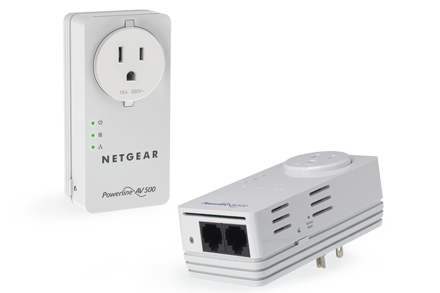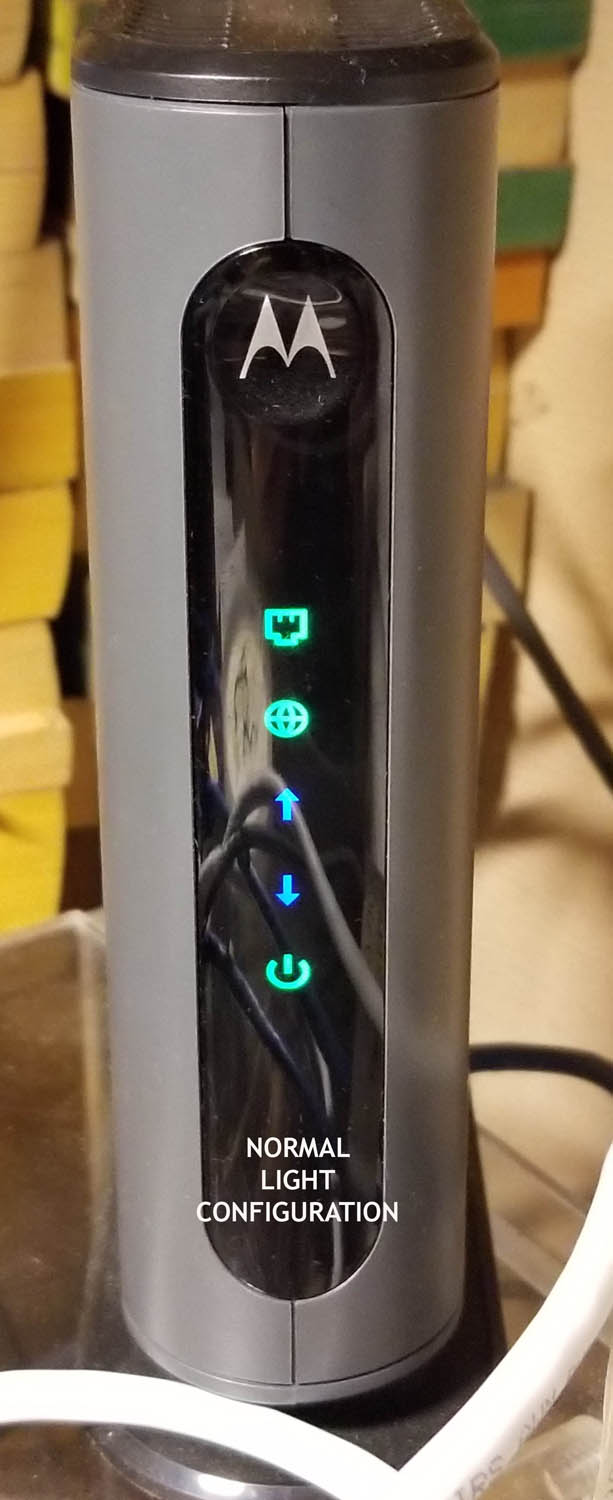MISCELLANEOUS NETWORK CONSIDERATIONS
This article deals with some network issues and topics that don't fit anywhere else.
NETWORK ELECTRICITY!
 Supposed that you have a location in or around your house where WIFI is unreliable, and all of your efforts to remediate the problem have not done so. What to do? You might consider power line networking. You purchase a kit which consists of two powerline adapters and two Ethernet cables. You plug one of the cables into your switch/route, the other end into one of the adapters and you plug that adapter into the nearest wall electrical outlet. You then connect the 2nd Ethernet cable into the device that you want to get connected (TV, computer, wireless repeater etc.) then the other end into the 2nd adapter and you plug that adapter into the nearest wall electrical outlet. That's it. The adapters recognize each other and auto-connect and you're connected. They use the electrical lines in your house as Ethernet cables and run network signal through them. It's not dangerous and won't affect anything electrical in your home. Your throughput will vary by a number of factors, but could be quite high...they do sell gigabit powerline kits now. I tried this route when I was attempting to get good Ethernet in my garage so I could locate another wireless access point. Turns out that the wiring in my house is so old that the throughput was not good enough to do so.But well worth a try for any hard-to-reach places in your home for a networking signal as the kits are not expensive. FYI better kits have a power outlet pass-through so you don't lose a power outlet to an adapter. Here's a rating for powerline adapters in 2020.
Supposed that you have a location in or around your house where WIFI is unreliable, and all of your efforts to remediate the problem have not done so. What to do? You might consider power line networking. You purchase a kit which consists of two powerline adapters and two Ethernet cables. You plug one of the cables into your switch/route, the other end into one of the adapters and you plug that adapter into the nearest wall electrical outlet. You then connect the 2nd Ethernet cable into the device that you want to get connected (TV, computer, wireless repeater etc.) then the other end into the 2nd adapter and you plug that adapter into the nearest wall electrical outlet. That's it. The adapters recognize each other and auto-connect and you're connected. They use the electrical lines in your house as Ethernet cables and run network signal through them. It's not dangerous and won't affect anything electrical in your home. Your throughput will vary by a number of factors, but could be quite high...they do sell gigabit powerline kits now. I tried this route when I was attempting to get good Ethernet in my garage so I could locate another wireless access point. Turns out that the wiring in my house is so old that the throughput was not good enough to do so.But well worth a try for any hard-to-reach places in your home for a networking signal as the kits are not expensive. FYI better kits have a power outlet pass-through so you don't lose a power outlet to an adapter. Here's a rating for powerline adapters in 2020.
BUILD YOUR OWN ROUTER
 If you are a tinkerer and feel fairly comfortable around computing terms and concepts, you might want to consider building your own router/access point. In fact you wouldn't be actually building it; rather, you'd be flashing open-source firmware onto it, creating a whole new router. You'd do this for additional features which make better use of the device's hardware, for enhanced security and greater control over the routers configuration as well as its behavior. These efforts are usually community-efforts of many people and open-source projects, so you can be assured that the code's not malicious as it can be inspected.
If you are a tinkerer and feel fairly comfortable around computing terms and concepts, you might want to consider building your own router/access point. In fact you wouldn't be actually building it; rather, you'd be flashing open-source firmware onto it, creating a whole new router. You'd do this for additional features which make better use of the device's hardware, for enhanced security and greater control over the routers configuration as well as its behavior. These efforts are usually community-efforts of many people and open-source projects, so you can be assured that the code's not malicious as it can be inspected.
Alternate firmware offers many advantages over proprietary manufacturer firmware including built-in OpenVPS, PPTP & L2TP allowing you to utilize your VPN subscription with multiple devices, dual WAN and 3G/4G fail-over options, the removal of manufacturer security holes (like manufacturer back doors), advanced networking modes, advanced QOS, personal web server and much much more. So a list of available features from "Freshtomato" (left).
Generally these firmware solutions need to be flashed onto specific router models, so if you're planning on going this route then be sure to obtain the correct router for the firmware you want to use.
There are two main groups to choose from, "Tomato" firmware or "DD-WRT". Both are full featured.
The security of these routers is outstanding and the ability to tweak them and do what your can't from the manufacturer is amazing. I had a customer once with his router/access point in the basement and his kids bedroom on the second floor, and they got terrible WIFI reception. He didn't want to spent a lot of money, or in fact ANY more money, so I took his router (which luckily was one that could be flashed) and flashed it with DD-WRT. This software enabled me to set broadcast transmit power from 0 to 100, so I was able to slowly ramp up its transmit power until I could get reliable WIFI upstairs. And it worked beautifully for years after that.
If you're interested check it out.
NETWORK TROUBLESHOOTING
Inevitably, you're going to have network problems and issues. I can't speak to yours specifically but I can offer some insights from many years of dealing with them.
Generally, your hardwired network is pretty failure-proof. In my experience it's much more common for the patch cables (short Ethernet cables) that run from the wall to the device to fail. I can only assume their flexibility causes them to do so (probably where the lines crimp into the connector) but fail they do, and it always leaves me frustrated as I always assume they are working and check everything else first. How can a cable fail???
It is quite possible however, for a component of your hardwired network to fail, like a switch, router, cable modem etc. If you lose connectivity, go downstream...check the device that is plugged into the computer that lsot connectivity. is it a switch? If so are there open ports? Then plug a laptop into it and see if it can get to the internet. If not, go downstream. Does that switch connect to another, maybe in your central network area? Then check that switch. Keep going downstream until you find a spot where nothing works, that's what probably failed. So far this year I've had my 16-port core switch fail, which is never any fun. I swapped an 8-port in place, but now I have no available ports in my core. In the past I've had routers fail as well as cable modems, so trust nothing when you lose connectivity and methodically test everything until you can localize the problem.
Wireless is much trickier to troubleshoot. If your wireless connection is slow, then ask yourself...is it location? Am I using a portable device (laptop, phone) and moving it father away from the access point transmitter? Am I moving to a place where a wall or something else interdicts the point-to-point connection between the two devices? Is there something nearby that interferes with the wireless signal? Is my wireless on a channel that all of my neighbor's wireless are on, degrading its performance? Is my access point too old to be transmitting the latest/fastest Ethernet? I cover some wireless issues in more detail here.
Nine out of ten times over the last 20 years, if I have a problem with my network it originated from Comcast. This last summer they were upgrading the infrastructure in my areas of the city, I'd see their trucks in the alley with ladders and workmen. And of course they crucified my internet. Many many phone calls, several visits by technicians, and it was almost unresolved, with the alst technician telling me that it was home coax Comcast network when he fortuitously checks and found my next door neighbor submitted a similar complaint. THEN he knew it was in the wires and had an exterior network tech check and repair them. One month of extreme frustration to get fixed!
FYI when you're working with techs and/or rebooting all your equipment to see if that'll work, remember that you have to do it in sequence. Unplug your cable modem or ATT box, and leave unplugged for 10 or more seconds. Unplug your router/access point(s). No need to mess with the switches. then plug in the cable modem and let it boot for 10 minutes or so. You should be able to see by the lights on the front of it's screen when its working. Only then plug in the router. That way, it can pick up an address form the cable modem / ATT box. PRO TIP: I took a picture of the front of my cable modem when it was working fine, then printed a color picture of it & hung it on the wall near the modem. This when when things begin to unravel, you can tell at a glance if it's working nominally.
